Study Guide
![]() Print (will print without answers)
Print (will print without answers)
To print with the answers, first select Expand All, then print
Section 4: Sample Multiple-Choice Questions
WEST–E Music: Instrumental (057)
The sample test questions in this study guide are designed to give you an introduction to the nature of the questions included in the Washington Educator Skills Tests—Endorsements (WEST–E). They represent the various types of questions you may expect to see on an actual test in this test field; however, they are not designed to predict your performance on the test as a whole.
Work through the sample questions carefully before referring to the answers. The correct response and test objective being assessed are provided for each question. When you are finished with the sample questions, you may wish to review the test objectives and descriptive statements provided in the test framework for this test field.
In addition to reading and answering the sample questions, you should also utilize the following preparation materials available in this study guide:
- Read Section 2: WEST–E Test-Taking Strategies to understand how test questions are designed to measure specific test objectives and to learn important test-taking strategies for the day of the test.
- Review Section 3: Test Summary and Framework to familiarize yourself with the structure and content of the test. This section contains general testing information as well as the percentage of the total test score derived from each content domain described in the test framework.
Practice Questions
Aural Skills
Objective 0001: Recognize elements of melody and harmony in recorded music.
1. Which of the following accurately represents the second chord of this example? (The example will be played twice.)
(The examinee listens to a recording of the two chords shown below played on the piano: 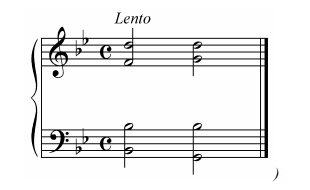
The graphic is a musical example. The example contains two chords written on a grand staff in four-four time. There are two flats in the key signature. The first chord contains the following pitches: B-flat2, B-flat3, F4, and D5. The second chord contains the following pitches: G2, B-flat3, G4, and D5.
Each of the four response options contains one chord written on a grand staff with two flats in the key signature.

Response option A contains the following pitches: E-flat3, B-flat3, E-flat4, and G4.
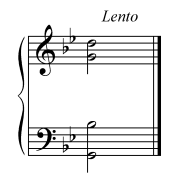
Response option B contains the following pitches: G2, B-flat3, G4, and D5.
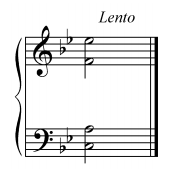
Response option C contains the following pitches: C3, A3, F4, and E-flat5.
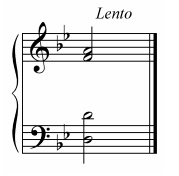
Response option D contains the following pitches: D3, D4, F4, and A4.
- Enter to expand or collapse answer.Answer expanded
- Correct Response: B.
2. Which of the following scales occurs in the excerpt? (The excerpt will be played twice.)
(The examinee listens to the first 15 seconds of Stevie Wonder’s “You are the Sunshine of My Life.”)
- whole tone
- pentatonic
- natural minor
- chromatic
- Enter to expand or collapse answer.Answer expanded
- Correct Response: A.
Objective 0002: Recognize elements of rhythm, tempo, timbre, articulation, and dynamics in recorded music.
3. Which of the following rhythmic patterns is demonstrated in this example? (The example will be played twice.)
(The examinee listens to a recording of the melody shown below played on the piano:

The graphic is a score excerpt for piano. The score excerpt is written in four-four time and is four measures long. As the item pertains to rhythm, the following will describe the rhythmic notation. Measure one contains three eighth notes, two quarter notes, and an eighth note. Measure two contains three eighth notes, a quarter note, and a dotted quarter note. Measure three contains three eighth notes, a quarter note, an eighth note, and a quarter note. Measure four contains a dotted quarter note, an eighth note, four sixteenth notes, and two quarter notes.
Each of the four response options include a rhythmic excerpt in four-four time that is four measures long.

Response option A includes the following rhythmic pattern: In measure one there three eighth notes, two quarter notes, and an eighth note. In measure two there are three eighth notes, a quarter note, and a dotted quarter note. In measure three there are three eighth notes, a quarter note, an eighth note, and a quarter note. In measure four there is a dotted quarter note, an eighth note, four sixteenth notes, and two eighth notes.

Response option B includes the following rhythmic pattern: In measure one there three eighth notes, two quarter notes, and an eighth note. In measure two there are three eighth notes, a quarter note, and a dotted quarter note. In measure three there is a triplet figure with three beamed eighth notes, a quarter note, an eighth note, and a dotted quarter note. In measure four there is a dotted quarter note, an eighth note, four sixteenth notes, and two eighth notes.

Response option C includes the following rhythmic pattern: In measure one there three eighth notes, two quarter notes, and an eighth note. In measure two there are three eighth notes, a quarter note, and a dotted quarter note. In measure three there are three eighth notes, two sixteenth notes, an eighth note, and a dotted quarter note. In measure four there is a dotted quarter note, an eighth note, four sixteenth notes, and two eighth notes.

Response option D includes the following rhythmic pattern: In measure one there three eighth notes, two quarter notes, and an eighth note. In measure two there are three eighth notes, a quarter note, and a dotted quarter note. In measure three there are two sixteenth notes, four eighth notes, two sixteenth notes, and a quarter note. In measure four there is a dotted quarter note, an eighth note, four sixteenth notes, and two eighth notes.
- Enter to expand or collapse answer.Answer expanded
- Correct Response: A.
4. Which of the following statements best characterizes the use of rhythm in the excerpt? (The excerpt will be played twice.)
(The examinee listens to the first 25 seconds of a movement from a violin partita by J. S. Bach.)
- The violin presents continuous quarter note triplets.
- The violin alternates between playing dotted figures and triplets.
- The violin renders a mixture of triplets and sextuplets.
- The violin plays dotted eighth notes followed by sixteenth notes throughout.
- Enter to expand or collapse answer.Answer expanded
- Correct Response: B.
Objective 0003: Demonstrate knowledge of historical, cultural, and stylistic contexts of recorded music.
5. This excerpt was most likely composed during which of the following periods?
(The examinee listens to a 25-second excerpt from a concerto composed by Antonio Vivaldi.)
- Renaissance
- Baroque
- Classical
- Romantic
- Enter to expand or collapse answer.Answer expanded
- Correct Response: B.
6. Which of the following styles of music best describes the excerpt? (The excerpt will be played twice.)
(The examinee listens to a 20-second clip of a calypso by Mighty Sparrow.)
- calypso
- mambo
- ska
- reggae
- Enter to expand or collapse answer.Answer expanded
- Correct Response: A.
Objective 0004: Detect errors in a recorded musical performance.
7. Use the score below and listen to the excerpt to answer the question that follows.

The graphic is a score excerpt for flute. The excerpt is written in two-eight time and is six measures long. As the item pertains for rhythmic error, the following will describe the rhythm of the measures in the response options. Measure two contains a sixteenth rest and a sixteenth note tied to a pair of sixteenth notes. Measure three contains three staccato sixteenth notes and a sixteenth rest. Measure four contains three staccato sixteenth notes and a sixteenth rest. Measure five contains two eighth notes.
In which of the following measures does the performer make an error in rhythm? (The excerpt will be played twice.)
(The examinee listens to a recorded performance of the musical score shown above. The flautist plays two sixteenth notes and an eighth note in measure 4.)
- measure 2
- measure 3
- measure 4
- measure 5
- Enter to expand or collapse answer.Answer expanded
- Correct Response: C.
8. Use the excerpt below and listen to the excerpt to answer the question that follows.
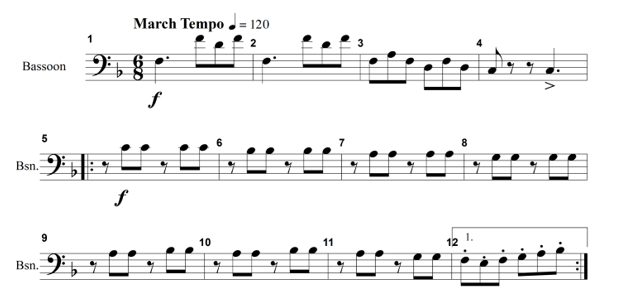
The graphic is a score excerpt for bassoon in the bass clef. It is in the key of F major and the meter is six-eight. The excerpt is twelve measures long with one repeat of measures 5-12. Since the question pertains to pitch, the following information will describe the written pitches in the four measures listed in the four response options. Measure 1 has a dotted quarter note on fourth line F followed by three beamed eighth notes: F three spaces above the staff, D two spaces above the staff, and F three spaces above the staff. Measure 3 has three beamed eighth notes on fourth line F, fifth line A, and fourth line F followed by three beamed eighth notes on third line D, fourth line F, and third line D. Measure 8 has an eighth rest, two beamed eighth notes on fourth space G, an eighth rest, and two beamed eighth notes on fourth space G. Measure 11 has an eighth rest, two beamed eighth notes on fifth line A, an eighth rest, and two beamed eighth notes on fourth space G.
In which of the following measures does the performer make an error in pitch? (The excerpt will be played twice.)
(The examinee listens to a recorded performance of the musical score by John Phillip Sousa shown above. The bassoonist plays an incorrect pitch on the fifth eighth note in measure 3.)
- measure 1
- measure 3
- measure 8
- measure 11
- Enter to expand or collapse answer.Answer expanded
- Correct Response: B.
Music Theory
Objective 0005: Apply knowledge of music notation systems and vocabulary.
9. Which of the following musical examples should be played at a quick and lively tempo?
Each of the response options contains a one-measure score excerpt in four-four time with a tempo marking.
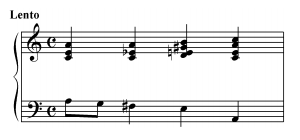
Response option A is marked "lento."
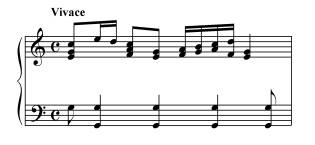
Response option B is marked "vivace."
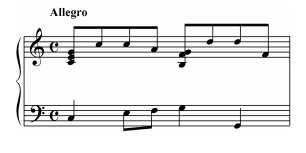
Response option C is marked "allegro."
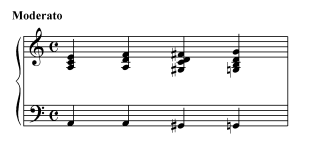
Response option D is marked "moderato."
- Enter to expand or collapse answer.Answer expanded
- Correct Response: B.
10. Use the example below to answer the question that follows.

The graphic shows a staff with an alto clef and one pitch. The pitch is a whole note on the second line of the staff. The note has a sharp in front of it.
Which of the following pitches is notated above?
- A-sharp
- B-sharp
- F-sharp
- G-sharp
- Enter to expand or collapse answer.Answer expanded
- Correct Response: A.
Objective 0006: Apply knowledge of melodic and harmonic elements of music.
11. Use the example below to answer the question that follows.
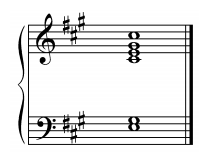
The graphic is a musical example. The example includes a chord written on a grand staff. There are three sharps in the key signature. The chord contains the following pitches: E3, G-sharp3, C-sharp4, E4, G-sharp4, and C-sharp5.
Which of the following is the best description of the chord shown above?
- iii superscript 6
- V superscript 6
- V superscript 7
- vii degrees
- Enter to expand or collapse answer.Answer expanded
- Correct Response: A.
12. Use the excerpt below to answer the question that follows.
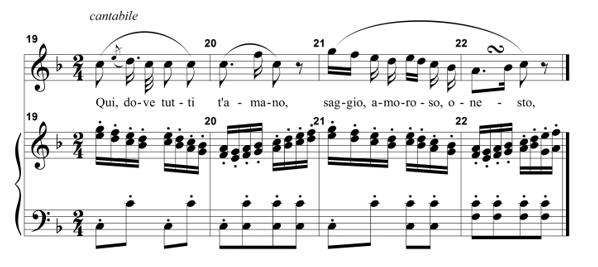
The graphic is a score excerpt from an opera aria by Gaetano Donizetti. The excerpt is four measures long and is written for soprano and piano. The key is F major and the meter is two-four. Italian lyrics are written below the soprano line. In measure 19, the first measure shown, above the Italian word “dove” there is a grace note with a stroke through it on fifth space E prefixed to a dotted sixteenth note on fourth line D.
Which of the following melodic embellishments appears in measure 19 above the Italian word “dove”?
- acciaccatura
- trill
- glissando
- turn
- Enter to expand or collapse answer.Answer expanded
- Correct Response: A.
Objective 0007: Apply knowledge of rhythmic and dynamic elements of music.
13. Use the example below to answer the question that follows.
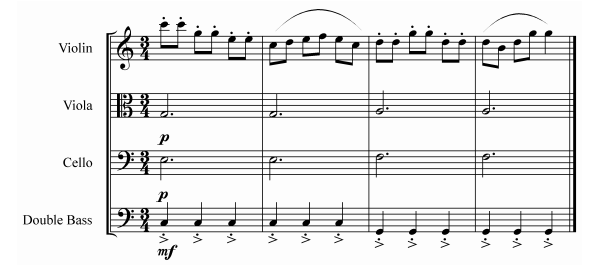
The graphic is a score excerpt for violin, viola, cello, and double bass. The measure contains six eighth notes. Above each eighth note, there is a small dot.
In measure 1, the symbol over each note in the treble clef indicates that the notes should be played in which of the following ways?
- smoothly connected
- suddenly louder
- gradually faster
- crisply detached
- Enter to expand or collapse answer.Answer expanded
- Correct Response: D.
14. Use the excerpt below to answer the question that follows.

The graphic is a score excerpt that purposefully omits the meter. The excerpt is six measures long and is written for xylophone. The monophonic melody is in B-flat major. Measure one has three quarter notes, a half note with a tremolo, and a quarter note. Measure two has two quarter notes, a dotted eighth-sixteenth pair, a dotted quarter note with a tremolo, and three staccato eighth notes. The rhythm in measure three is the same as measure one. Measure four is the same as measure three but transposed up a diatonic step with the top note having an accent. Measure five has the same rhythm as the previous measure but with an additional accent on the final quarter note. The last measure has a half note with an accent and a tremolo, a quarter note, an accented quarter note, and two quarter rests.
Which of the following time signatures is implied in this excerpt?
- four fourths
- four halves
- six eighths
- six fourths
- Enter to expand or collapse answer.Answer expanded
- Correct Response: D.
Objective 0008: Apply knowledge of musical forms and styles.
15. Use the example below to answer the question that follows.

The graphic is a short melody written in treble clef and is in four-four time. The melody is one measure long. It includes eighth note E5 beamed to two sixteenth notes on E5, eighth note D5 beamed to two sixteenth notes D5 and E5, eighth note D5 beamed to two sixteenth notes on C5, and quarter note C5.
Which of the following represents an augmentation of the melody shown above?
Each of the four response options is a short melody written in treble clef and is in four-four time.

Response option A is one measure long and includes the following: eighth note G5 beamed to two sixteenth notes on G5, eighth note F5 beamed to two sixteenth notes F5 and G5, eighth note F5 beamed to two sixteenth notes on E5, and quarter note E5.

Response option B is one measure long and includes the following: eighth note G5 beamed to two sixteenth notes on G5, F-sharp5 beamed to two sixteenth notes F-sharp5 and G5, eighth note F-sharp5 beamed to two sixteenth notes on E-sharp5, and quarter note E-sharp5.

Response option C is two measures long and includes the following: quarter note E5, two beamed eighth notes on E5, quarter note D5, two beamed eighth notes on D5 and E5, quarter note D5, two beamed eighth notes on C5, and a half note on C5.

Response option D is two measures long and includes the following: quarter note C5, two sixteenth notes on C5 beamed to eighth note D5, two sixteenth notes on E5 and D5 beamed to eighth note D5, and two sixteenth notes on E5 beamed to eighth note E5.
- Enter to expand or collapse answer.Answer expanded
- Correct Response: C.
16. Use the excerpt below to answer the question that follows.
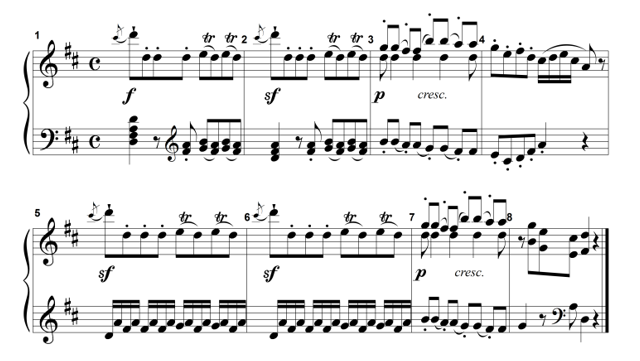
The graphic is a score excerpt of a piano sonata movement by Franz Joseph Haydn. The excerpt is written for keyboard and is eight measures long. It is in the key of D major and the meter is common time. There is a half cadence in measure four and a perfect authentic cadence in measure eight. Measures 1-3 and measures 5-7 contain the same melodic material in the right hand and follow the same harmonic structure.
Which of the following periodic phrase structures is presented in the excerpt?
- nonmodulating contrasting period
- modulating contrasting period
- nonmodulating parallel period
- modulating parallel period
- Enter to expand or collapse answer.Answer expanded
- Correct Response: C.
Music History and Culture
Objective 0009: Demonstrate knowledge of Western music from various historical periods.
17. Which of the following string instruments was widely used in the music of the Renaissance period?
- lyre
- harp
- mandolin
- lute
- Enter to expand or collapse answer.Answer expanded
- Correct Response: D.
18. Lieder composed by Clara Schumann are characteristic of the romantic period primarily for which of the following reasons?
- They drew inspiration from emotions, nature, and poetry.
- They prioritize virtuosic passages that highlight the skills of a singer.
- They include highly chromatic passages that break with tonality.
- They allow for singers to add their own embellishments to the melody.
- Enter to expand or collapse answer.Answer expanded
- Correct Response: A.
Objective 0010: Demonstrate knowledge of jazz, folk, blues, and popular music found within the United States.
19. Which of the following U.S. composers was preeminent in the field of band music in the twentieth century?
- Scott Joplin
- John Philip Sousa
- Louis Armstrong
- George M. Cohan
- Enter to expand or collapse answer.Answer expanded
- Correct Response: B.
20. Songs in a pop vocal style that include the use of strings, horns, and tambourine are most representative of which of the following styles of music?
- country
- Motown
- folk
- rock and roll
- Enter to expand or collapse answer.Answer expanded
- Correct Response: B.
Objective 0011: Demonstrate knowledge of World music from diverse cultural sources.
21. Which of the following instruments was most likely recreated in Central America by Africans who were taken as slaves?
- panpipes
- scraper
- steel drums
- marimba
- Enter to expand or collapse answer.Answer expanded
- Correct Response: D.
22. Rhythmic chanting is mostly likely to occur in which of the following dance traditions?
- haka
- samba
- hora
- flamenco
- Enter to expand or collapse answer.Answer expanded
- Correct Response: A.
Music Creation and Performance
Objective 0012: Demonstrate knowledge of techniques for composing, improvising, and arranging music.
23. Use the example below to answer the question that follows.

The graphic is a score excerpt. The excerpt is a short melody written in treble clef, in four-four time, and is two measures long. The first measure contains dotted quarter note C5, eighth note A4, beamed eighth notes B4 and C5, and quarter note D5. Measure two contains quarter note E5, dotted quarter note F5, eighth note E5, and quarter note C5.
Which of the following represents the retrograde of the melody shown above?
Each of the response options is a short melody written in treble clef, in four-four time, and is two measures long.

Response option A contains the following: quarter note C5, eighth note E5, dotted quarter note F5, quarter note E5, quarter note D5, beamed eighth notes C5 and B4, eighth note A4, and dotted quarter note C5.

Response option B contains the following: dotted quarter note C5, eighth note G4, beamed eighth notes A4 and B4, quarter note E5, quarter note F5, dotted quarter note G5, eighth note E5, and quarter note C5.

Response option C contains the following: dotted quarter note C5, eighth note E5, beamed eighth notes D5 and C5, quarter note B4, quarter note A4, dotted quarter note G4, eighth note A4, and quarter note C5.

Response option D contains the following options: dotted quarter note D5, eighth note B4, beamed eighth notes C5 and D5, quarter note E5, quarter note F5, dotted quarter note G5, eighth note F5, and quarter note D5.
- Enter to expand or collapse answer.Answer expanded
- Correct Response: A.
24. When arranging a song for a high school SATB chorus, which of the following ranges is most appropriate for the soprano part?
- G3 to D5
- C4 to G5
- C4 to D6
- G3 to C5
- Enter to expand or collapse answer.Answer expanded
- Correct Response: B.
Objective 0013: Demonstrate knowledge of basic performance techniques for string instruments.
25. When looking at a string orchestra from the conductor's perspective, which of the following instruments is traditionally placed at the end of the semicircle on the left?
- first violin
- second violin
- viola
- cello
- Enter to expand or collapse answer.Answer expanded
- Correct Response: A.
26. A beginning violist plays sharp when playing open strings. Which of the following techniques would most likely help the violist play in tune?
- decreasing the bow speed on the strings
- applying greater bow pressure to the strings
- turning the pegs to loosen the strings
- attaching a set of thinner strings
- Enter to expand or collapse answer.Answer expanded
- Correct Response: C.
Objective 0014: Demonstrate knowledge of basic performance techniques for woodwind instruments.
27. For saxophone players, which of the following is the most common cause of poor staccato?
- Too much of the mouthpiece is in the mouth.
- Too little of the mouthpiece is in the mouth.
- Too much of the lower lip is over the teeth.
- Too little sustained breath support is used.
- Enter to expand or collapse answer.Answer expanded
- Correct Response: D.
28. In a traditional orchestra seating plan, from the conductor’s perspective the bassoons are most often placed in which of the following locations?
- to the immediate left of the piccolos
- in the second row alongside the oboes
- toward the back next to the basses
- behind the oboes and next to the clarinets
- Enter to expand or collapse answer.Answer expanded
- Correct Response: D.
Objective 0015: Demonstrate knowledge of basic performance techniques for brass instruments.
29. For brass players, which of the following is the most common cause of poor staccato?
- improper tongue position
- insufficient breath support
- excessive mouthpiece pressure
- too much pressure on upper lip
- Enter to expand or collapse answer.Answer expanded
- Correct Response: A.
30. The right hand is placed in the bell of a valved French horn primarily for which of the following purposes?
- to affect pitch and timbre
- to perform chromatic pitches
- to help with quick virtuosic passages
- to control the dynamic level
- Enter to expand or collapse answer.Answer expanded
- Correct Response: A.
Objective 0016: Demonstrate knowledge of basic performance techniques for pitched and nonpitched percussion instruments.
31. When playing the bass drum, a percussionist can best produce strong accents by striking:
- the center of the drumhead with a beater.
- a glancing blow with timpani sticks.
- a perpendicular blow with a rubber mallet.
- the center of the drumhead with a soft mallet.
- Enter to expand or collapse answer.Answer expanded
- Correct Response: A.
32. Which of the following steps is most likely to ensure that a snare drum produces a uniform sound across the entire snare head?
- tightening all lug nuts with a drum tuning key, working in a counterclockwise direction around the counter hoop
- removing and re-screwing all lug nuts with a drum tuning key to ensure that they are uniformly tightened along the counter hoop
- using a cross-tuning pattern by tightening a lug nut with a drum tuning key and then tightening the lug nut directly across on the counter hoop
- checking by hand the tightness of each lug nut of the counter hoop and tightening with a drum tuning key the lug nuts that feel loose
- Enter to expand or collapse answer.Answer expanded
- Correct Response: C.
Objective 0017: Demonstrate knowledge of rehearsal techniques for soloists, chamber groups, bands, and orchestras.
33. Which of the following components of the human voice generates the sound for singing?
- the pharynx, mouth, and nasal cavity
- the respiratory muscles
- the tongue, teeth, and lips
- the vocal cords
- Enter to expand or collapse answer.Answer expanded
- Correct Response: D.
34. An alto who is experiencing throat tension after chorus rehearsal would likely benefit most from which of the following technical adjustments?
- taking quicker and more frequent breaths
- lowering the larynx and raising the soft pallet
- singing at a softer dynamic level
- tucking the chin slightly for high notes
- Enter to expand or collapse answer.Answer expanded
- Correct Response: B.
Objective 0018: Demonstrate knowledge of conducting and repertoire selection.
35. When an alto saxophonist plays a written fourth-line D in treble clef, which of the following concert pitches will sound?

The graphic shows a staff with a treble clef. A whole note F appears in the first space of the staff.

The graphic shows a staff with a treble clef. A whole note D appears directly below the bottom line of the staff.

The graphic shows a staff with a treble clef. A whole note E flat appears on the first line of the staff.

The graphic shows a staff with a treble clef. A whole note C appears one ledger line below the staff.
- Enter to expand or collapse answer.Answer expanded
- Correct Response: A.
Music and other Disciplines
Objective 0019: Demonstrate knowledge of music as a form of communication.
36. Which of the following elements of music would a composer typically consider first when creating a new work?
- rhythm
- form
- harmony
- texture
- Enter to expand or collapse answer.Answer expanded
- Correct Response: B.
37. Pete Seeger revived and performed folk songs from diverse sources primarily for which of the following purposes?
- entertaining an influx of people moving into American cities
- supporting various movements, such as the Civil Rights Movement
- providing dance music to baby boomers at social gatherings
- recreating the songs in the rock and roll style, using electric instruments
- Enter to expand or collapse answer.Answer expanded
- Correct Response: B.
Objective 0020: Analyze how music relates to other arts disciplines and academic subject areas.
38. A music teacher can best support a science teacher's presentation about sound wavelengths and frequencies by demonstrating the:
- installation of a complete set of strings on a string instrument.
- attachment of a reed to a mouthpiece.
- relationship between pitch and string length.
- effects of using various mallet types on a keyboard percussion instrument.
- Enter to expand or collapse answer.Answer expanded
- Correct Response: C.
39. Which of the following activities exemplifies how a teacher can best incorporate Social and Emotional Learning into a traditional middle school music classroom?
- asking students to compile and share lists of songs they identify with and why
- presenting students with new music to sight-read as an ensemble
- taking students on a field trip to a recording studio
- teaching students about the history of songs from various countries
- Enter to expand or collapse answer.Answer expanded
- Correct Response: A.
Objective 0021: Demonstrate knowledge of careers related to music.
40. Which of the following areas of college course work would be most important to an individual who wants to be a music journalist?
- technology
- music theory
- English
- music history
- Enter to expand or collapse answer.Answer expanded
- Correct Response: C.